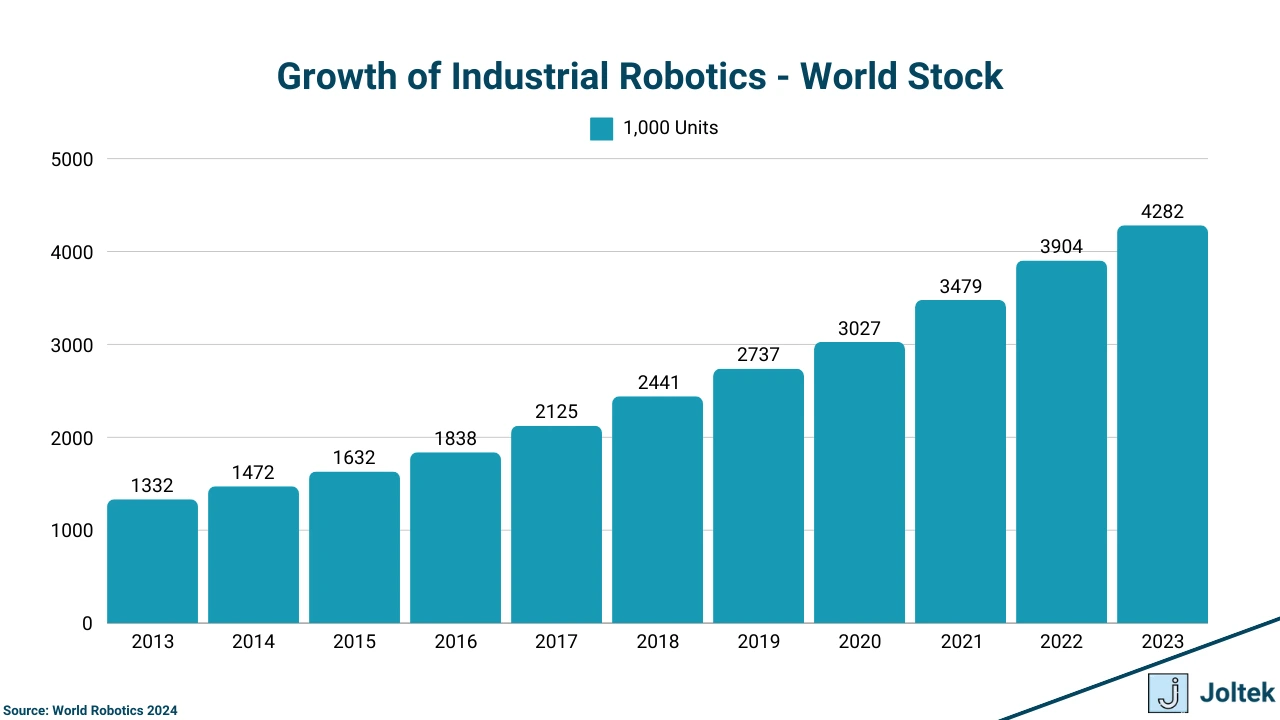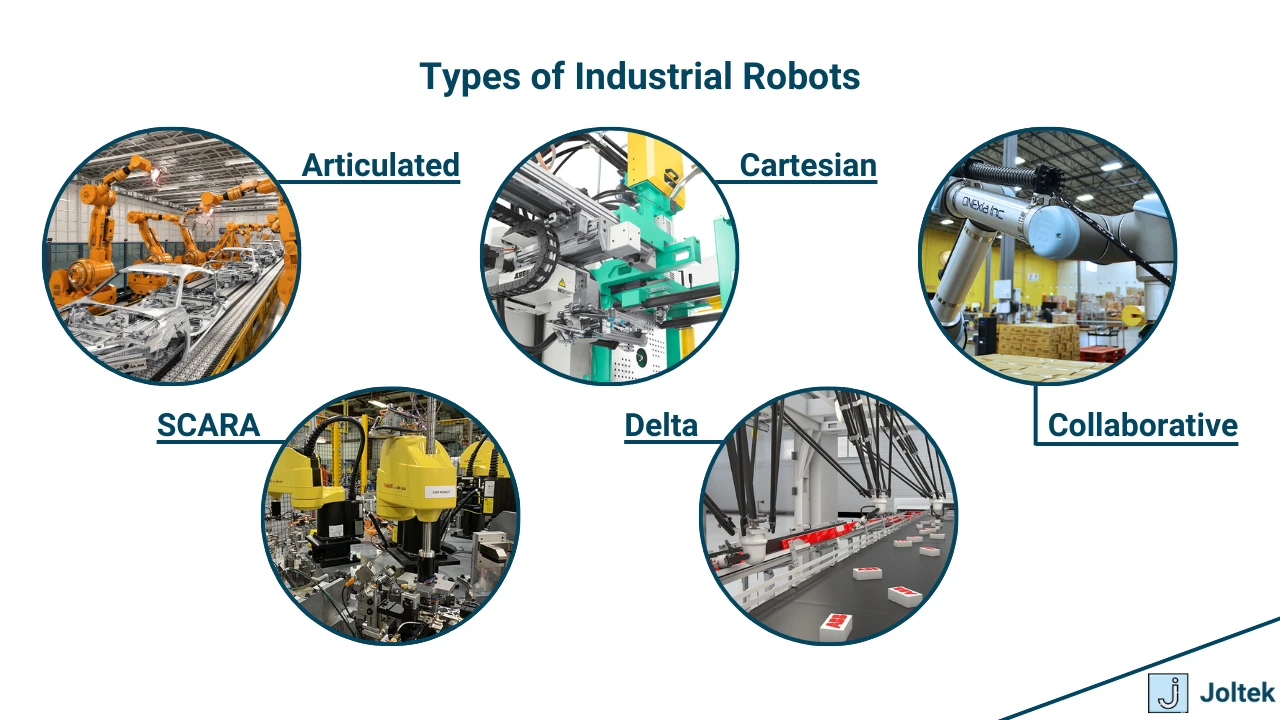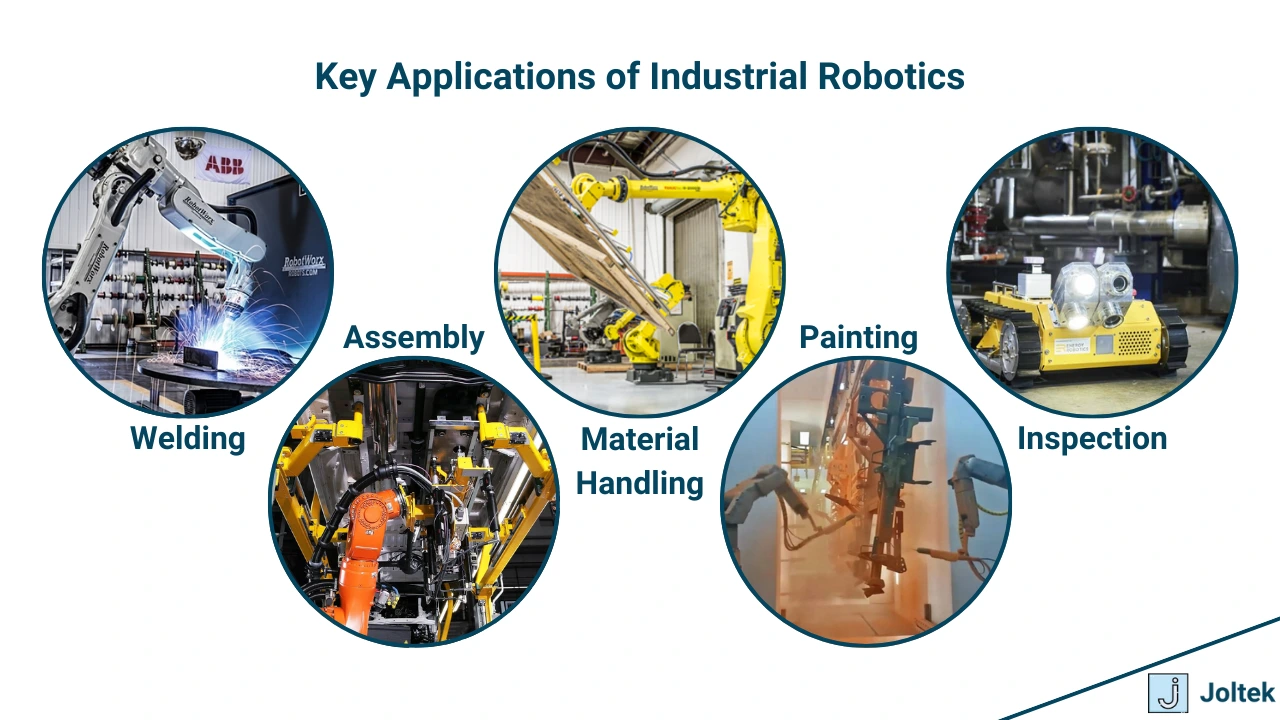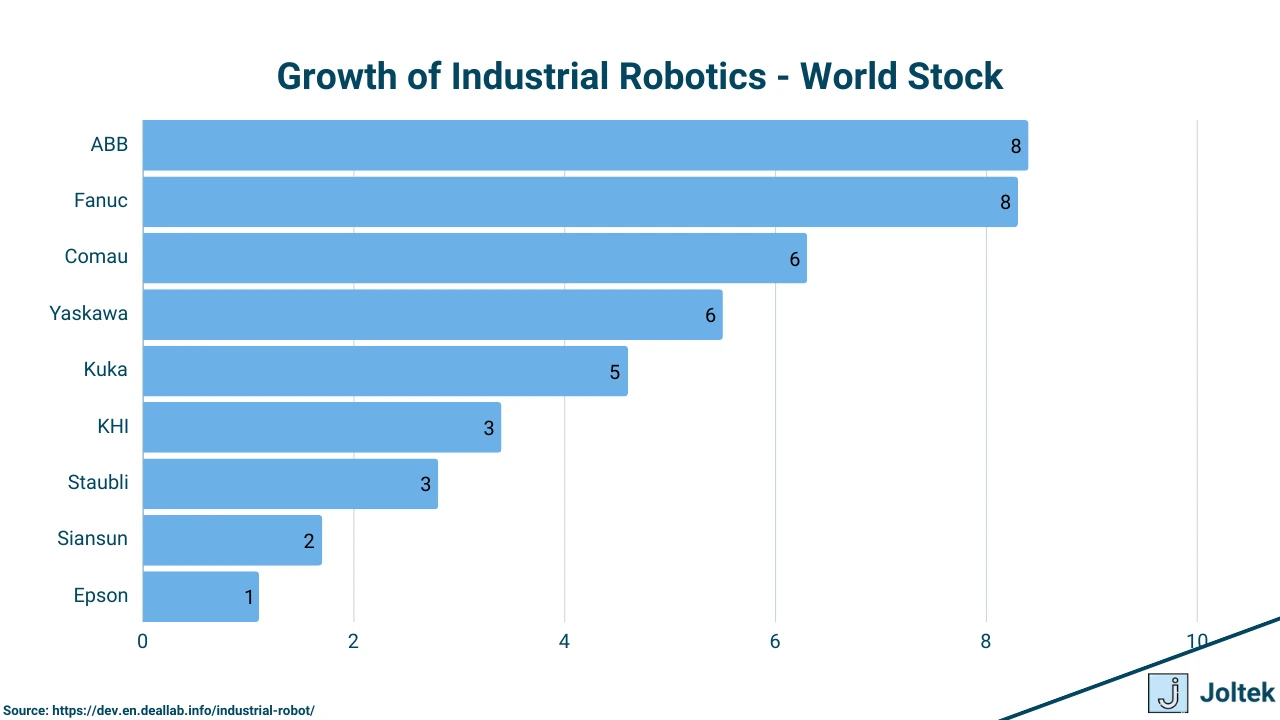Industrial robots are programmable, automated machines designed to perform complex tasks with precision, speed, and consistency. Unlike traditional machinery, these robots can adapt to various applications, making them indispensable in industries like manufacturing, logistics, automotive, and electronics. From assembling products on a factory floor to optimizing supply chains in warehouses, industrial robots have become a cornerstone of modern production processes.
As companies face increasing pressure to enhance efficiency, reduce costs, and meet the demands of a globalized market, industrial robotics are no longer optional—they are essential. The integration of robotics enables businesses to stay competitive, improve safety by automating hazardous tasks, and achieve higher levels of quality and scalability.

The journey of industrial robotics began in the mid-20th century and has evolved into a sophisticated, multi-billion-dollar industry. Key milestones include:
These advancements have positioned industrial robotics as a transformative force across multiple industries.
The numbers tell a compelling story. In 2022, global industrial robot sales exceeded 500,000 units, a record-breaking figure that reflects the growing demand for automation. According to the International Federation of Robotics (IFR), the industrial robotics market is expected to grow at a compound annual growth rate (CAGR) of 10% between 2023 and 2030, driven by adoption in sectors like logistics, food and beverage, and electronics.
Regions like Asia-Pacific lead the charge, with countries such as China, Japan, and South Korea accounting for over 70% of robot installations. Meanwhile, North America and Europe are rapidly catching up, driven by investments in advanced manufacturing and warehouse automation.
With the rapid evolution of robotics, businesses are faced with an overwhelming number of choices: different types of robots, a variety of programming protocols, and a host of vendors promising cutting-edge solutions. Choosing the right system for your needs—whether you’re operating a small facility or a global enterprise—requires a clear understanding of the options available and the factors that matter most.
This guide is designed to help you:
Whether you’re a technical expert or a decision-maker, this comprehensive guide will equip you with the insights needed to navigate the complex world of industrial robotics and drive your business forward.
Industrial robots are as diverse as the industries they serve, with each type of robot uniquely suited for specific tasks. Understanding these distinctions is critical for businesses aiming to enhance efficiency and precision in their operations. Below is an in-depth look at the major categories of industrial robots, their characteristics, and their applications.
Articulated robots are perhaps the most recognizable in industrial settings. These robots feature rotary joints that allow them to mimic the range of motion of a human arm. With anywhere from four to six axes (or more), articulated robots excel in complex and versatile tasks, offering exceptional flexibility.
Articulated robots are widely used in automotive assembly lines for tasks like welding and painting. Their ability to handle heavy payloads while maintaining precision makes them indispensable for industries requiring high levels of accuracy. Despite their higher cost, their adaptability and robustness often deliver significant long-term value.
Selective Compliance Assembly Robot Arm (SCARA) robots are designed for high-speed, repetitive tasks within a single plane. Their compact design makes them ideal for environments with limited space, and they are known for their ability to rapidly execute pick-and-place operations with accuracy.
SCARA robots are heavily utilized in electronics manufacturing, where placing delicate components requires both speed and precision. Their lower cost and straightforward deployment make them attractive for small-to-medium enterprises looking to automate their operations without a significant upfront investment.
Cartesian robots, also known as gantry robots, operate along three linear axes: X, Y, and Z. Their simple design and movement make them highly reliable for tasks that require straight-line precision, such as CNC machining and 3D printing.
These robots are especially popular in applications like material handling and stacking. Their ease of programming and cost-effective design appeal to industries focused on precision manufacturing, particularly when rotational movement is unnecessary.
Delta robots are known for their speed and lightweight structure. With three arms connected to a base, these robots are built for high-speed applications like sorting and packaging. Their ability to handle delicate items with precision has made them a staple in the food, pharmaceuticals, and electronics industries.
For example, delta robots are used to sort confectioneries on a production line or package electronic components in blister packs. While their application is limited to lightweight tasks, their unparalleled speed and precision make them highly effective in their niche.
Collaborative robots, or cobots, are redefining human-robot interaction by working alongside humans in shared workspaces. Unlike traditional robots, cobots are equipped with advanced sensors and safety protocols to prevent accidents, enabling them to safely assist in tasks like assembly and quality testing.
Cobots are especially beneficial for small manufacturers due to their ease of programming, scalability, and lower cost compared to traditional industrial robots. They enhance productivity without the need for extensive infrastructure changes, making them a flexible solution for businesses across various industries.

Selecting the right robot is critical to achieving operational efficiency and maximizing ROI. While articulated robots may be the gold standard for heavy-duty tasks, SCARA or cobots may be more appropriate for precision assembly or smaller-scale operations. By understanding the strengths and limitations of each type, decision-makers can tailor their investments to their specific needs, ensuring a balanced approach to automation.
Industrial robotics have revolutionized modern manufacturing and logistics, delivering unprecedented levels of efficiency, precision, and safety. From welding intricate automotive parts to automating warehouse operations, these versatile machines are reshaping industries worldwide. Below, we explore the key applications of industrial robots, showcasing their transformative impact.
Overview:
Robots excel in welding and assembly tasks that require precision, consistency, and speed. Articulated robots, with their multi-jointed arms, are particularly adept at handling complex welds or assembling components in tight spaces.
Real-World Example:
In the automotive industry, robots are used to weld car frames, ensuring consistent joint quality and reducing production times. Tesla’s manufacturing lines are a prime example, where robots perform a mix of spot welding, seam welding, and assembly tasks with high efficiency.
Benefits:
Overview:
Material handling robots streamline operations by automating the movement of goods, loading/unloading machines, and palletizing products for shipment. Cartesian and articulated robots are commonly used for these tasks.
Real-World Example:
In the food and beverage sector, material handling robots sort and palletize bottles, cans, and packages with precision, minimizing the risk of product damage. Coca-Cola’s facilities use robots to palletize thousands of beverage cases daily, ensuring rapid and accurate stacking.
Benefits:
Overview:
Painting and coating are tasks that demand a flawless finish and uniform application, making them ideal for robotic automation. Articulated robots equipped with spray nozzles are often used for this purpose.
Real-World Example:
In aerospace manufacturing, robots apply coatings to aircraft fuselages with precision, ensuring consistent thickness and coverage. This reduces material waste and ensures compliance with stringent safety standards.
Benefits:
Overview:
Robots equipped with advanced sensors, cameras, and AI algorithms are increasingly used for non-destructive testing and visual inspections, identifying defects that may be missed by the human eye.
Real-World Example:
Electronics manufacturers use vision-enabled robots to inspect circuit boards for micro-defects. Samsung’s production lines employ robots for quality control, ensuring flawless assembly of smartphones and other devices.
Benefits:
Overview:
Pick-and-place robots, such as SCARA and delta robots, are designed for high-speed sorting and placement tasks, making them indispensable in fast-paced industries like packaging and electronics.
Real-World Example:
In the pharmaceutical industry, robots sort and package medications with high precision, ensuring compliance with stringent health regulations. Delta robots in particular excel in picking lightweight items and placing them into packaging at speeds unmatched by humans.
Benefits:
Overview:
Logistics and warehouse automation have been transformed by robots capable of picking, packing, sorting, and transporting goods. Collaborative robots (cobots) and autonomous mobile robots (AMRs) play a significant role in this domain.
Real-World Example:
Amazon’s warehouses employ thousands of robots to move shelves, pick orders, and assist workers in packing, reducing delivery times significantly. This hybrid human-robot system has set a new standard in e-commerce logistics.
Benefits:

According to the International Federation of Robotics (IFR):
These figures underscore the growing adoption of robotics across industries, highlighting their critical role in modern manufacturing and logistics.
Selecting the right industrial robot can make or break your automation strategy. The decision hinges on several critical factors, from the complexity of your application to the scalability of your operation. In this section, we’ll explore the key criteria businesses must evaluate to ensure the best fit for their needs, whether they operate in a small facility or a large-scale manufacturing plant.
The first step in choosing an industrial robot is understanding the task it will perform. Robots designed for simple pick-and-place tasks differ significantly from those required for complex welding or assembly operations.
Key Tip: Define the level of precision, speed, and flexibility required for your operations. For example, if you need to handle varied product shapes, a robot with advanced adaptability like a collaborative robot (cobot) may be your best choice.
The physical space in your facility is another critical factor. Some robots require extensive room for movement, while others are compact and designed for tight spaces.
Key Tip: Evaluate not only the floor space but also the vertical clearance needed for robotic arms or gantry systems.
The weight and size of the materials or products a robot needs to handle directly impact your selection.
Key Tip: Ensure the robot’s reach aligns with the dimensions of your production area to avoid unnecessary repositioning or extensions.
Investing in a robot should be a forward-looking decision. Consider whether the robot you choose can adapt to future changes in production volume or complexity.
Key Tip: Look for robots that can be reprogrammed or retrofitted as your business grows or your product lines diversify.
Budget constraints are a reality for any business, but it’s essential to balance upfront costs with the long-term return on investment (ROI).
Key Tip: Factor in the total cost of ownership (TCO), including maintenance, programming, and training expenses, when calculating ROI.
The robot you choose must seamlessly integrate with your existing production line and IT systems. This includes compatibility with software, communication protocols, and other machinery.
Key Tip: Work with a systems integrator to ensure the robot aligns with your existing technology and infrastructure.
The needs of small and large facilities vary significantly. Tailoring your approach ensures you get the most value from your investment.
Example: A small food production company might use a SCARA robot to package baked goods, while a large automotive manufacturer employs articulated robots for welding and assembly on high-speed production lines.
Selecting the right vendor for your industrial robotics needs is just as important as choosing the right robot. Vendors play a critical role in ensuring smooth implementation, ongoing support, and scalability for your operations. Below, we provide an overview of leading industrial robotics vendors and the key factors you should consider when evaluating them.

Overview: Fanuc is one of the largest manufacturers of industrial robots globally, with a wide portfolio of solutions for industries like automotive, electronics, and packaging.
Key Strengths:
Case Study: Fanuc’s robots have been used extensively in Tesla’s Gigafactories for high-speed, high-precision assembly tasks.
Overview: ABB is a leader in industrial automation, offering solutions for manufacturing, logistics, and robotics integration. Their focus on sustainability and smart systems has set them apart.
Key Strengths:
Testimonial: A leading electronics manufacturer praised ABB’s robots for reducing production downtime by 20% through predictive maintenance features.
Overview: KUKA specializes in flexible and customizable robotics solutions, with a strong presence in automotive and general manufacturing. Their robots are known for their precision and ease of integration.
Key Strengths:
Case Study: KUKA robots are widely used by BMW for welding and assembly in their automated production lines, improving cycle times and consistency.
Overview: Yaskawa, operating under the Motoman brand, is renowned for its welding and material handling robots, offering solutions tailored to diverse industries.
Key Strengths:
Testimonial: A heavy equipment manufacturer highlighted Yaskawa’s robots for their durability and accuracy in handling oversized components.
Overview: Universal Robots pioneered the collaborative robot (cobot) space, creating robots that are safe, affordable, and easy to deploy. They cater primarily to SMEs.
Key Strengths:
Case Study: A small bakery implemented Universal Robots cobots to handle repetitive packaging tasks, increasing production efficiency by 30% without expanding its workforce.
Overview: Known for their innovative robotics designs, Boston Dynamics has shifted focus to logistics with robots like Stretch and Spot.
Key Strengths:
Testimonial: A major e-commerce company integrated Boston Dynamics’ Stretch robots into its warehouses, reducing human labor for repetitive unloading tasks and increasing safety.
When evaluating vendors, consider the following factors to ensure a successful partnership:
User Reviews and Testimonials:
Case Studies:
Choosing the right vendor depends on your specific needs, including the complexity of your application, budget, and long-term goals. By carefully evaluating vendors based on the criteria above and leveraging real-world insights, you can make an informed decision that drives efficiency and productivity in your operations.

Industrial robots require precise programming to perform complex tasks with accuracy and efficiency. Understanding the programming languages and communication protocols used in robotics is crucial for seamless integration and operation. This section delves into the most commonly used programming languages and protocols, highlighting their applications and suitability for various industries.
Overview: RAPID is ABB’s proprietary programming language designed for its robotic systems. Known for its straightforward syntax and versatility, it allows users to program a wide range of tasks, from simple pick-and-place operations to complex, multi-step sequences.
Applications:
Advantages:
Overview: KUKA’s proprietary language, KRL, is designed for high customization and flexibility in robotic applications. It provides detailed control over robot movements, making it suitable for intricate tasks like welding and painting.
Applications:
Advantages:
Overview: Fanuc robots are programmed using a teach pendant interface, which provides a user-friendly environment for creating motion paths and logic operations.
Applications:
Advantages:
Overview: Python has gained popularity in industrial robotics due to its flexibility and integration with AI and machine learning tools. It is often used for developing custom robotic applications or connecting robots to external systems like databases or IoT platforms.
Applications:
Advantages:
Overview: ROS is an open-source robotics middleware that provides a collection of tools and libraries for building robot applications. It is particularly popular in research and prototyping environments.
Applications:
Advantages:
Robots rely on communication protocols to interact with other machines, sensors, and control systems. Choosing the right protocol ensures seamless integration and data exchange.
Overview: EtherCAT is a high-performance protocol used for real-time communication in industrial automation.
Applications:
Advantages:
Overview: Profinet is an Ethernet-based protocol commonly used for industrial automation. It allows robots to communicate with programmable logic controllers (PLCs) and other devices.
Applications:
Advantages:
Overview: Modbus is a lightweight and widely adopted protocol used for simple communication between industrial devices.
Applications:
Advantages:
Overview: MQTT is a lightweight messaging protocol often used for IoT applications. Its publish-subscribe model makes it ideal for connecting robots to cloud systems.
Applications:
Advantages:
Selecting the right programming language and communication protocol depends on your specific requirements, such as application complexity, integration needs, and workforce expertise. Whether you’re programming a robot for precision welding or integrating IoT-enabled robots into a logistics system, understanding these tools is critical for success.
Industrial robotics is at the forefront of technological evolution, continuously adapting to meet the demands of modern industries. Emerging trends and innovations are shaping the future of robotics, offering transformative solutions that go beyond traditional automation. From AI-driven robotics to sustainable energy-efficient designs, here are the key trends and predictions defining the future of industrial robotics.
Artificial intelligence is revolutionizing industrial robotics by enabling machines to learn, adapt, and optimize performance in real time.
Example: Amazon utilizes AI-driven robotics in its warehouses, where robots equipped with vision and machine learning can sort and handle items dynamically, significantly reducing operational delays.
Impact: AI integration is expected to reduce downtime by up to 20% and improve overall production efficiency by 15% in industries like manufacturing and logistics.
Collaborative robots (cobots) are breaking barriers for small and medium enterprises (SMEs) by offering cost-effective and flexible automation solutions.
Example: A small electronics manufacturer implemented cobots for pick-and-place operations, reducing labor costs by 30% and achieving a return on investment within one year.
Projection: According to the International Federation of Robotics (IFR), cobot adoption is projected to grow by 20% annually, with SMEs driving the majority of this growth.
The Robots as a Service (RaaS) model is reshaping how businesses adopt robotics by lowering the upfront costs associated with purchasing and implementing robots.
Example: A logistics firm adopted RaaS for seasonal order surges, renting additional robots during peak periods to manage increased workloads.
Market Insight: The RaaS market is expected to reach $34 billion by 2030, driven by the growing need for flexible automation solutions in industries like e-commerce and manufacturing.
As industries prioritize sustainability, robotics manufacturers are designing energy-efficient systems to reduce carbon footprints and operational costs.
Example: ABB’s energy-efficient robots are used in automotive manufacturing, reducing energy usage by 25% compared to older models.
Impact: Sustainable robotics is expected to play a significant role in helping industries meet global carbon reduction targets, particularly in energy-intensive sectors like automotive and heavy manufacturing.
The industrial robotics market is poised for exponential growth, driven by technological advancements and increased adoption across industries.
As robotics continues to evolve, businesses must stay ahead by:
By aligning with these trends, companies can not only enhance productivity but also future-proof their operations against the demands of an increasingly automated world.
Industrial robotics has left a transformative mark across various industries, with companies leveraging robotic solutions to streamline operations, improve safety, and boost productivity. Below are some detailed examples showcasing how robotics is revolutionizing manufacturing, logistics, and beyond.
Use Case:
In automotive manufacturing, robots are indispensable for welding operations. Articulated robots equipped with advanced sensors and vision systems perform spot welding and seam welding with unparalleled precision.
Example:
Toyota employs over 3,000 robots across its manufacturing plants worldwide. In its Kentucky facility, welding robots have reduced production time for car frames by 25%, ensuring consistent weld quality while reducing material waste.
Impact:
Use Case:
Small and medium-sized food factories are increasingly adopting collaborative robots (cobots) to enhance safety and streamline repetitive tasks.
Example:
A small bakery in Denmark implemented cobots from Universal Robots for repetitive packaging tasks. The cobots work alongside employees to package baked goods, increasing production efficiency by 30% while improving worker safety by reducing repetitive strain injuries.
Impact:
Use Case:
Robotics has transformed warehouse operations for e-commerce giants like Amazon, enabling faster order fulfillment and efficient inventory management.
Example:
Amazon’s robotics division, Amazon Robotics, has deployed over 520,000 mobile robots in its warehouses globally. These robots transport shelves of goods to human packers, reducing the time it takes to locate and pick items.
Impact:
Use Case:
In electronics manufacturing, where precision is paramount, robotics ensures consistent assembly of delicate components and thorough quality inspections.
Example:
Foxconn, a major supplier for Apple, uses thousands of robots in its assembly lines. Robots handle tasks like soldering, screwing, and product testing, ensuring high-quality standards for devices like iPhones and MacBooks.
Impact:
Use Case:
Pharmaceutical companies are deploying robotics to ensure precision in packaging and stringent compliance with health and safety regulations.
Example:
Pfizer uses delta robots to sort and package medications at high speeds. These robots operate in sterile environments, maintaining the integrity of products while ensuring accurate labeling and packaging.
Impact:

Investing in industrial robotics is a significant step toward increasing productivity and staying competitive. However, the success of this investment depends on careful planning, informed decision-making, and effective implementation. Here’s a step-by-step guide to help businesses choose and deploy robotics tailored to their needs.
Before diving into automation, it’s critical to assess your business requirements and identify specific pain points.
Key Questions to Ask:
Example: A food manufacturer identified packaging as a bottleneck and opted for a SCARA robot to streamline the process.
A system integrator can help design, install, and integrate robotics into your operations. Their expertise ensures seamless coordination between robots, existing machinery, and IT systems.
Benefits of System Integrators:
Tip: Choose a system integrator with experience in your industry and familiarity with the specific robotics platform you’re adopting.
The cost of industrial robotics extends beyond the initial purchase price. Calculating the total cost of ownership (TCO) is essential to ensure a realistic financial plan.
Key Cost Components:
Example: A small manufacturer determined that while a cobot had a higher upfront cost, its low maintenance requirements and energy efficiency delivered a higher ROI over five years compared to traditional robots.
Robotics can only deliver value if the workforce is prepared to operate and collaborate with them. Training programs are essential to build employee confidence and ensure smooth operations.
Training Focus Areas:
Tip: Collaborative robots (cobots) are often easier to train for, making them ideal for businesses with limited technical resources.
Deploying robotics isn’t a one-and-done process. Thorough testing and iterative improvements are critical to maximizing the system’s potential.
Steps to Follow:
Example: An electronics manufacturer ran a pilot with delta robots for packaging and adjusted the programming to accommodate changes in product dimensions, reducing errors by 15%.
Step
Key Actions
Conduct Needs Assessment
Identify tasks to automate and desired outcomes.
Partner with Integrators
Collaborate with experienced system integrators for seamless deployment.
Budget for TCO
Account for all costs: purchase, installation, maintenance, and training.
Train Workforce
Provide training to ensure employees can operate and maintain the robots.
Test and Iterate
Pilot and refine the system before full deployment.
Industrial robotics is a transformative investment, but success lies in preparation and strategic implementation. By following these steps, businesses can maximize the ROI from their robotic systems while minimizing disruptions during the transition.
Industrial robotics is no longer a luxury reserved for large enterprises—it is a necessity for businesses looking to remain competitive in today’s fast-paced and demanding markets. Robots drive efficiency, enhance precision, and foster innovation across industries, from automotive assembly lines to logistics warehouses.
Throughout this guide, we’ve explored the diverse types of industrial robots, their key applications, and actionable steps to implement them successfully. Whether you’re managing a small facility or a global operation, the potential for transformation through robotics is immense.
The decision to adopt robotics should start with a careful evaluation of your specific needs, challenges, and goals. Consider:
By thoughtfully answering these questions and leveraging the insights shared in this guide, you can embark on a journey that not only boosts productivity but also sets your business apart as an industry leader.
Ready to explore your options? Whether you’re looking to implement your first robotic system or expand an existing one, we’re here to help. Contact us today for tailored advice, resources, and solutions to drive your automation goals forward.
Your next step toward efficiency, innovation, and growth starts now.